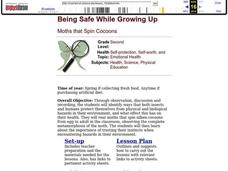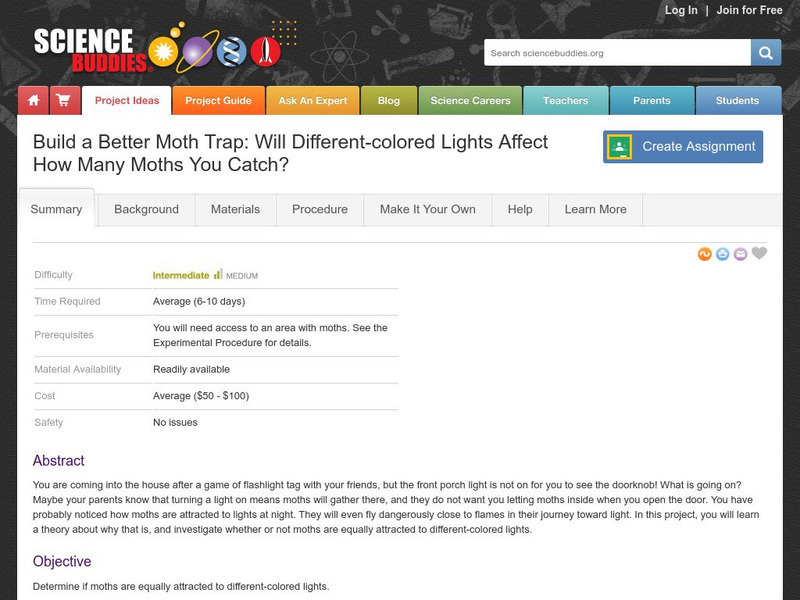Curated OER
Butterflies and Moths- Order Lepidoptera
In this butterfly and moth learning exercise, students describe the difference between the two as well as label different parts of a butterfly and moth.
Curated OER
Moth
For this animal facts worksheet, students will read information about moths including what they eat and where they live. Then students will color a picture of a moth.
Curated OER
Being Safe While Growing Up
Second graders identify ways that both insects and humans protect themselves from physical and biological hazards in their environment. They rear moths from egg to adult and consider the importance of trusting their own instincts.
PBS
Pbs Learning Media: Moths
Scientists conduct an experiment to learn about moths' attraction to light in this video segment from WILD TV. [4:10]
Science Buddies
Science Buddies: Build a Better Moth Trap With Different Colored Lights
Can you affect the behavior of moths by using different colored lights to attract them? This extensive science fair project from Science Buddies gives lots of suggestions on how to set up an experiment and variations of that experiment...
Iowa State University
Iowa State University: Entomology Image Gallery
This site provides an extensive collection of photographs of insects.
Other
Insects.org: Insects on the Web
Explore the fascinating stories of insects and the roles they play in our lives. Check out the photos and descriptions, learn how they help humans, find some great educational resources, and much more.
Other
Iowa State University: Bug Guide: Moths
The learning resource is a guide to a better understanding of moths. Some topics investigated are the identification, numbers, and size of the moth. In addition to an information guide the activity has pictures of moths.
Iowa State University
Iowa State University: Iowa Insect Information Notes Butterflies and Moths
This series of articles is about butterflies and moths that you may see around your house. There is a special focus on the caterpillars that will become the moths because they cause most of the damage to trees.
University of Michigan
University of Michigan Critter Catalog: Insects
A thorough site that provides a description of the characteristics of insects and then focuses on the insects of southeastern Michigan. Pictures, classification groupings, and sound clips of insects are included.
Museum of Science
Mo S: Image Gallery of the Scanning Electron Microscope
At this resource you'll find everything from a mosquito head to a fly foot, from a dentist's drill to toilet paper! These and just about everything in between as seen through a scanning electron microscope.
Texas Instruments
Texas Instruments: Like Moths Around a Flame
In this activity, students will examine the historical natural selection model of peppered moths. Students can use the calculator to enhance their understanding of the model by analyzing patterns in long-term data of light colored and...
Environmental Education for Kids
Eek!: Creepy Critter Feature
Discover all you can about various "creepy" critters, including bats, snakes, spiders, cicadas, leeches, ticks, moths, pupas, lampreys and fleas.
Sheppard Software
Sheppard Software: Moths
This site gives a brief description of a moth, including its behavior, appearance, and classification. The site includes photos and illustrations and an interactive quiz to test your understanding.
Ed Koday
Web Archive: Luna Moths
Luna moths are one of the most unusual and beautiful of the North American moths known as Saturnidae. They are well known for their green-yellow colors and long tails,and although they are often seen in pictures, they are a real surprise...
Ed Koday
Web Archive: Ceropia Moth
With a wingspan of 5 to 6 inches, the cecropia moth (Hyalophora cecropia) is the largest North American moth. It is a member of the family Saturniidae. Cecropia moths are often referred to as silkworm moths.Although these moths are...
Ed Koday
Web Archive: Gypsy Moths
Lean more information about Gypsy Moths by reading this reference material.
Ed Koday
Web Archive: Io Moth
The Io moth, named for a character in Greek mythology, has a very obvious black eyespot on each hindwing. Males are golden yellow in color, but females are more brown. It has a wingspan of 2.5-3.5 inches. In Canada and northern states,...
Enchanted Learning
Enchanted Learning: Silkworm Moth
Information about the silkworm moth with a labeled diagram.
Other
Union County College: The Mulberry Tree and Its Silkworm Connection
An explanation of the relationship between the silkworm and the mulberry tree, required for the production of silk.
Other
Bobmyx Mori: The China Silkworm
This article provides a day-by-day account of the hatching, feeding, spinning, silk harvesting, and breeding of silkworms, with photographs of each step and process. Very detailed.
Regents of the University of Michigan
Animal Diversity Web: Bombyx Mori (Silkworms)
Biological information about the silkworm, Bombyx mori, including habitat, physical description, behavior, food habits, and more.
Popular Science
Popular Science: Scientists Color Silk by Feeding Silkworms Fabric Dyes
Account of experiments scientists are performing to get silkworms to produce colored silk.
BBC
Bbc Nature: Woolly Bear Moths
It is not surprising that this family of moths is commonly called woolly bears or woolly worms, as the caterpillars of many species are really very hairy. The larvae can be full of poisonous chemicals acquired from their host plants,...
















